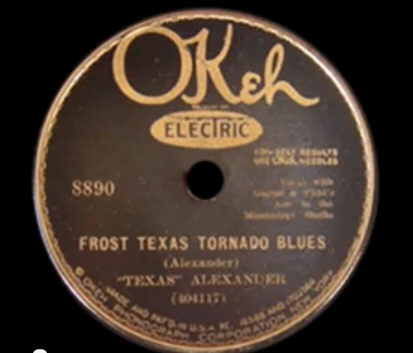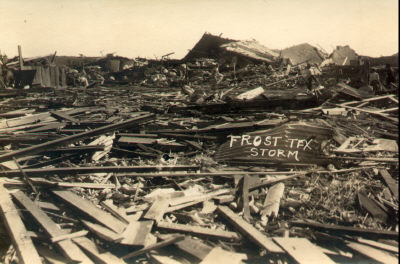Legendary blues singer, Alger “Texas” Alexander was born in Jewett, Texas, north of Houston in 1900. In 1934, Alger composed and sang with his big, deep voice the Frost Texas Tornado Blues. Just four years earlier a F4 tornado ripped through the town of Frost just south of Dallas. Sixty were killed and many more never found. The entire town was leveled and a mass funeral occurred on the porch of the only house left standing.
I was sitting looking: way out across the world
Said the wind had things switching: almost in a twirl
Says I been a good fellow: just good as I can be
Says it’s Lord have mercy: Lord have mercy on me
Mmm: mmm
Says I been a good fellow: just as good as a man could be
Some lost their baby: was blowing for two three miles around
When they come to their right mind: they come on back to town
Said rooster was crowing cows was lowing: never heard such a noise before
Does it seem like hell was broke out: in this place below
 Although we still sing the blues about tornadoes, much has changed since the 1930’s with regard to tornadoes. We have better home construction and much, much better warnings now. However, knowing exactly when and where a tornado will occur…well that is a bit more challenging.
Although we still sing the blues about tornadoes, much has changed since the 1930’s with regard to tornadoes. We have better home construction and much, much better warnings now. However, knowing exactly when and where a tornado will occur…well that is a bit more challenging.
Let me clarify.
With ever-increasing precision we can predict, and warn, of conditions that are likely to produce a tornado. The ingredients—wind shear, instability, heat and moisture, and forcing mechanism—are mesoscale phenomena that can be modeled, quantified, and even predicted. Roger Edwards, lead forecaster at the Storm Prediction Center described the intricate process that it takes to predict a thunderstorm and tornado outbreak days to a week in advance. “It takes a combination of skill, luck, and a team of people. The key is trying to predict a phenomenon not just temperature and rain.” Data of different types—wind, temperature, moisture—at scales ranging from the globe to North America to a particular county in Oklahoma must all be integrated. The data itself comes from satellite, aircraft observations, weather balloons, weather stations, and radar. All of this data must be assimilated and ran through multiple modes that would fry your home computer and probably your neighbor’s on top of that. Then the computers spit out an answer. Of course that answer might be garbage. “Let’s not forget the human element to see that models are going awry. You need to conceptualize in three dimensions what is going on in atmosphere. We still analyze charts by hand which causes us to slow down and think with pencils and paper in hand. Our experience is vital. “
But these ingredients form a supercell, not a tornado itself, and not all supercells produce tornadoes. “The atmosphere has a way of getting the four together in ways with minor differences to either create a large EF5 tornado or a just some rain. We don’t know when and where these ingredients form in just the right way,” states Edwards. Indeed, 70% of the time a tornado warning is issued no tornado actually forms. It’s important to understand this error would be much worse if it were reversed. In other words, if 70% of the time a tornado occurred no tornado warning was issued. That is the major advance I’m talking about.
Scientists still have little idea what causes tornadogensis particularly those microscale phenomena, those minor winds, temperature, and pressure differences that occur in areas less than a mile to less than football field that trigger the whole shoot and caboodle. Measuring, analyzing, and modelling this is the cutting edge of tornado research. In the last several weeks, I have been speaking with the biggest names in tornado researchers from Virginia to Oklahoma to Illinois. I asked everyone what is the biggest question in tornado science. Every one of them responded that the holy grail, my word not theirs, is the when, where, and how of which storm will make a tornado.
Charles Doswell is a meteorologist who although did not originate the concept of supercell, that’s thanks to a Brit named Keith Browning, did with Les Lemon improve Browning’s idea that gave us the modern conceptual model of supercells and how they form. That paper from 1979 is one of the most cited papers in meteorology and tornado science. I’ll leave with Charles’s words from our recent conversation. “We are still struggling with the area of tornadogenesis. Apparently you need every single one of the details…and very high confidence in them too.” Perhaps it’s fitting that Doswell and “Texas” Alexander share more in common that a fascination with tornadoes. Doswell is too a lover of the blues, perhaps fitting for a tornado scientist, and used to host a blues radio show.
